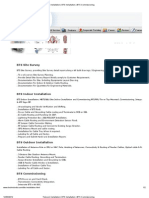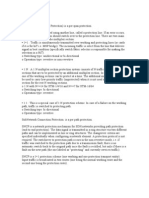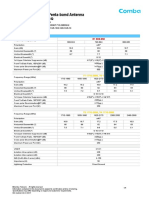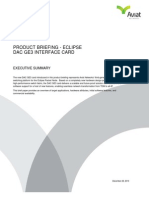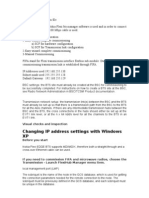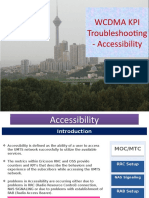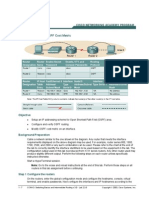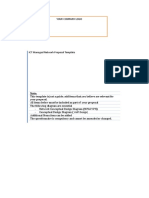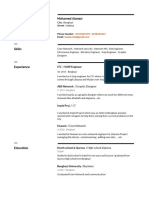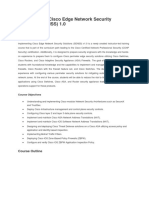Ceragon IP 10 - LAG
Ceragon IP 10 - LAG
Uploaded by
dennyCopyright:
Available Formats
Ceragon IP 10 - LAG
Ceragon IP 10 - LAG
Uploaded by
dennyOriginal Description:
Copyright
Available Formats
Share this document
Did you find this document useful?
Is this content inappropriate?
Copyright:
Available Formats
Ceragon IP 10 - LAG
Ceragon IP 10 - LAG
Uploaded by
dennyCopyright:
Available Formats
Proprietary and Confidential
(IEEE 802.3ad)
Link Aggregation
Load Balance Example
Applications
Feature Review
Advantages
Definition
Agenda
Agenda
Proprietary and Confidential
a load balancing function
Proprietary and Confidential
Traffic sent to the ports in such a group is distributed through
instances of full duplex point-to-point links operating at the
same data rate
The Link Aggregation Group is consisting of N parallel
together to form a Link Aggregation Group, such that a MAC
Client can treat the Link Aggregation Group as if it were a
single link
Link Aggregation allows one or more links to be aggregated
IEEE Definition:
Introduction to Link Aggregation
Advantages
Proprietary and Confidential
100 Mbps
The capacity of the multiple links is combined into one logical link.
Link Aggregation allows the establishment of full duplex point-to-point links
that have a higher aggregate bandwidth than the individual links that form the
aggregation.
1. Increased aggregate bandwidth
Benefits of using Link Aggregation
Proprietary and Confidential
Traffic via LAG is distributed according to users policy improved reliability
In case of a failed link, remaining links take over utilization of new available BW
2. Improved Resiliency
Benefits of using Link Aggregation
Proprietary and Confidential
STP requires blocking and
path cost calculations
With LA STP or routing protocols are not needed, therefore, less processing is involved.
When multiple ports are allocated between 2 Routers, Routing Protocols are required to
control traffic paths.
When multiple ports are allocated between two ETH switches, broadcast storms are
created due to physical loops. STP is required to eliminate loops by blocking the redundant
port.
3. Reduced Complexity & Administration
Benefits of using Link Aggregation
>> we trunk N x FE ports
Proprietary and Confidential
Instead of utilizing an expensive GbE port(s) to transport 200Mbps
4. Reduced Cost
Benefits of using Link Aggregation
Multiple
Interfaces
Proprietary and Confidential
Customer
Network
Single
Interface
(These examples refer to using L2 topologies as well)
Public
Network
For sites that need to hide the existence of internal interfaces, the IP address of
the aggregation hides its interfaces from external applications.
For sites with limited IP address space that nevertheless require large amounts of
bandwidth, you need only one IP address for a large aggregation of interfaces.
5. Improved Network Efficiency / Security
Benefits of using Link Aggregation
Feature Review
11
Proprietary and Confidential
This provides better statistical load balancing.
2. Hash (default):
In this method the hash function (used by the traffic switch for address table lookups)
is used to select one of the ports in the group.
This method can be used for testing & debugging.
1. Simple XOR:
In this method the 3 LSBs of DA and SA are XORed and the result is used to select
one of the ports in the group.
Two methods are available for Link Aggregation Group traffic distribution:
Traffic sent to ports in a group is distributed through a load balancing function.
LAG Distribution Policy
12
MAC (HEX)
00:20:8f:0a:02:01
00:20:8f:0a:01:01
00:20:8f:0a:02:02
00:20:8f:0a:01:02
00:20:8f:0a:02:03
00:20:8f:0a:01:03
00:20:8f:0b:e1:03
00:20:8f:0a:e1:04
00:20:8f:0b:e1:03
00:20:8f:0a:e1:01
00:20:8f:0b:e1:07
00:20:8f:0a:e1:04
Stream
SA ->
- > DA
SA ->
- > DA
SA ->
- > DA
SA ->
- > DA
SA ->
- > DA
SA ->
- > DA
Proprietary and Confidential
111
100
010
101
011
010
011
011
010
010
001
001
Last 3 bits
(Configure your Traffic Generator with the following MACs)
011 (3)
010 (2)
001 (1)
000 (0)
000 (0)
000 (0)
XOR result
Link #4
Link #3
Link #2
Link #1
Link #1
Link #1
Assigned LAG Port
We can easily demo balanced traffic distribution using the XOR method
LAG Distribution: Simple XOR
13
Proprietary and Confidential
7. A LAG may contain from 1 to 5 physical ports
6. There may be up to 3 LAGs per IDU
5. All ports in a LAG must be in the same IDU (same switch)
4. LAG is not supported in a Single Pipe mode
3. LAG is supported in IDUs configured as Managed or Metro switch
2. Management ports / WSC ports cannot be grouped in a LAG
1. Only traffic ports (including radio port) can belong to a LAG
Static LAG guidelines
14
Proprietary and Confidential
11. Dynamic Link Aggregation (LACP) is not supported
10. The LAG will initially receive default values for these parameters
xSTP role (edge, non-edge)
path cost
9. When a LAG is created, it will automatically inherit all the ports
characteristics, except for the following:
8. LAGs are virtual ports that do not permanently exist in the system
Static LAG guidelines (continued)
15
FE
GbE
8
IP-10 IDU
Proprietary and Confidential
GbE
FE
8
IP-10 IDU
Ports 1-2 (GBE ports) and ports 3-7 (FE only ports) cannot be in the same LAG
group even if the GBE ports are configured as 100Mbps.
Grouping ports in LAG
16
FE
GbE
8
IP-10 IDU
Proprietary and Confidential
GbE
Radio port (port 8) may be in a LAG with the GBE ports only
Grouping ports in LAG
FE
8
IP-10 IDU
Applications
18
GbE
PHY
Proprietary and Confidential
Multiple Radio System
implemented with LAG
Port #2 and Radio
form a LAG
Single Pipe
Stackable
(Nodal) Site
GbE
PHY
Multiple FE
ports as a LAG
Standalone Site
Multiple PHYs are grouped together to support a higher capacity PHY.
Grouped ports are known as LAG Link Aggregation Group.
Introduction to Link Aggregation
3rd party
Switch or Router
19
Proprietary and Confidential
Dual (redundant) GbE interfaces facing the Switch/Router
Static Link Aggregation Group (or equivalent) configured on the Switch/Router
interfaces connected to the IP-10
Any failure in the local GbE interfaces will be handled by the link aggregation mechanism
Static LAG
1+0 LAG
20
No need for LAG
1+1 HSB or
2+0 Multi-Radio
(traffic interruption <50mSecs)
Proprietary and Confidential
MW Radio link switchovers are transparent to Switch/Router
STBY IP-10 GbE interface is disabled
Optical splitter/combiner is used to connect to each of the IP-10 GbE interfaces in
(1+1) protected configuration
Single GE interfacing a 3rd party Switch/Router
3rd party
Switch or Router
1+1 HSB W/O LAG
Static LAG
No need for LAG
1+1 HSB or
2+0 Multi-Radio
21
Proprietary and Confidential
Dual (redundant) GE interfaces facing the 3rd party Switch/Router
Static Link Aggregation Group (or equivalent) is configured on the Switch/Router
interfaces connected to the IP-10 units
STBY IP-10 disables its Ethernet interface towards the Switch/Router
As a result, the Switch/Router sends all traffic over the Ethernet interface connected to
the active IP-10
Any failure detected in radio link or Ethernet interface will trigger a switch-over to the
back-up unit with <50msecs traffic interruption on the radio link
The Switch/Router detects the switch-over and start sending traffic over the interface
connected to the new active unit only
3rd party
Switch or Router
1+1 HSB With LAG
Static LAG
1+1 HSB or
2+0 Multi-Radio
22
Proprietary and Confidential
Dual (redundant) GE interface to the Switch/Router
Static Link Aggregation Group (or equivalent) is configured on the Switch/Router
interfaces connected to the IP-10s
Static Link Aggregation Group (or equivalent) is configured on the IP-10
2 optical splitter/combiners are used to connect each of the 2 interfaces on the
Switch/Router to each of the corresponding interfaces on the IP-10s
3rd party
Switch or Router
Static LAG
Static LAG
1+1 HSB With dual GbE + LAG
Static LAG
1+1 HSB or
2+0 Multi-Radio
23
Proprietary and Confidential
Any failure in the local GbE interfaces will be handled by the link aggregation
mechanism without triggering switch-over to the back-up IP-10 unit!
STBY IP-10 disables its Ethernet interface towards the Switch/Router
Any failure detected in radio link or equipment will trigger switch-over to the back-up
IP- 10 unit with <50msecs traffic interruption on the radio link
3rd party
Switch or Router
Static LAG
Static LAG
1+1 HSB With dual GbE + LAG (cont.)
Load Balance Example
25
Port #2 and Radio
form a LAG
50%
50%
Proprietary and Confidential
GbE port #1 = (50% via Radio #1) + (50% via Radio #2)
Traffic injected via GbE port #1 is distributed evenly between Port #2 & Port #8
Port #2 is linked to a Pipe IDU, hence, a Multi-Radio system is achieved:
IDU #2 is configured as Single Pipe
IDU #1 is configured as Managed Switch to support LAG
GbE
PHY
Load balance example
26
1)
2)
3)
4)
5)
P
1
4) Port 2 is out
of the LAG
2) Alarm is
propagated
Proprietary and Confidential
Enable Automatic State Propagation on both IDUs
Radio #2 encounters a signal degradation
Since ASP is enabled, the alarm is propagated to port #1
IDU #1 detects the alarms and shuts down port #2
Port #2 is not part of the LAG
Radio #1 takes full control (100%) of traffic
GbE
PHY
3) Port 1 is
shut down
Load balance example
100%
5) Radio 1
takes 100%
X
50%
1) Link
Degradation
Shut down
100%
X
50%
64QAM
100%
256QAM
27
Proprietary and Confidential
To improve system resiliency, Automatic State Propagation can shut down the
LAG interface when ACM degrades below a pre-determined profile.
GbE
PHY
Load balance example
28
Proprietary and Confidential
training@ceragon.com
Thank You !
You might also like
- User Manual - Fiplex Compact RepeatersDocument26 pagesUser Manual - Fiplex Compact Repeaterscrispix2000No ratings yet
- Nokia Siemens Network DWDMDocument1 pageNokia Siemens Network DWDMrohit00722No ratings yet
- MEF On The GO 1.0.120617V2Document1,058 pagesMEF On The GO 1.0.120617V2Jay Singh100% (2)
- Nokia SRC Scalable IP Exam Sample Questions Document enDocument7 pagesNokia SRC Scalable IP Exam Sample Questions Document enMendez OmoNo ratings yet
- 9.4.2.8 Packet Tracer - Skills Integration Challenge InstructionsDocument2 pages9.4.2.8 Packet Tracer - Skills Integration Challenge Instructionsstxavier5000No ratings yet
- MT CNADocument5 pagesMT CNARama SaputraNo ratings yet
- 241 - Ceragon - LAG CONFIG - Presentation v1.0Document17 pages241 - Ceragon - LAG CONFIG - Presentation v1.0mehdi_mehdi0% (1)
- Siklu EH-1200 Install & User Manual - EH-InSTL-02 - Issue1Document226 pagesSiklu EH-1200 Install & User Manual - EH-InSTL-02 - Issue1Cristian BujorNo ratings yet
- Microwave Nec Pasolink Neo by Akash RayDocument48 pagesMicrowave Nec Pasolink Neo by Akash RayAntonio P. Souza JuniorNo ratings yet
- ETX-5300A: Ethernet Service Aggregation PlatformDocument612 pagesETX-5300A: Ethernet Service Aggregation Platformcafe0sugarNo ratings yet
- 05 iPASO LCT Training Manual (Ethernnet) Dec2012-2Document105 pages05 iPASO LCT Training Manual (Ethernnet) Dec2012-2Wubie NegaNo ratings yet
- What Is Optical Power BudgetDocument6 pagesWhat Is Optical Power BudgetAmir SalahNo ratings yet
- Ceragon - 1+1 Resilient Microwave Links - Technical BriefDocument8 pagesCeragon - 1+1 Resilient Microwave Links - Technical BriefzrzahzahNo ratings yet
- Sdh/Sonet: Alarms & Performance MonitoringDocument141 pagesSdh/Sonet: Alarms & Performance MonitoringMohammed KumaylNo ratings yet
- Cables and Connectors Printed Circuit Boards (PCBS) Packaging of Components & Ics Electronic InterconnectionsDocument35 pagesCables and Connectors Printed Circuit Boards (PCBS) Packaging of Components & Ics Electronic InterconnectionsARAVINDNo ratings yet
- HUAWEI DBS3900 Dual-Mode Base Station Hardware Structure and PincipleDocument75 pagesHUAWEI DBS3900 Dual-Mode Base Station Hardware Structure and PincipleJordan Tuazon Unidad100% (1)
- RW2000 PTP Installation Release 2.8.20Document87 pagesRW2000 PTP Installation Release 2.8.20edaxterNo ratings yet
- FlexiMetro PresentationDocument46 pagesFlexiMetro PresentationtelexpertNo ratings yet
- 2 Degree ROADM: Signal FlowDocument5 pages2 Degree ROADM: Signal FlowSery ArthurNo ratings yet
- Gpon Gpon Gpon GponDocument79 pagesGpon Gpon Gpon Gponabtin_kameliiNo ratings yet
- Department of Electronics and Telecommunication: Pillai College of Engineering New Panvel - 410 206Document16 pagesDepartment of Electronics and Telecommunication: Pillai College of Engineering New Panvel - 410 206Venkatraman SubramanianNo ratings yet
- Ceragon Ceragon Licenses Secure Management Licens IP 20 SL SEC MAN SICE Distributore ItalianoDocument258 pagesCeragon Ceragon Licenses Secure Management Licens IP 20 SL SEC MAN SICE Distributore Italianoosvaldo franciscoNo ratings yet
- Optix NG WDM Maintenance Case Collection PDFDocument10 pagesOptix NG WDM Maintenance Case Collection PDFtelec10No ratings yet
- Pathloss 5Document32 pagesPathloss 5shubham guptaNo ratings yet
- ION Series: ION™-M S EriesDocument6 pagesION Series: ION™-M S Eriesshaan19No ratings yet
- Fiber Optic Cable ProductsDocument48 pagesFiber Optic Cable ProductsUdriste DanielNo ratings yet
- Alcatel AlarmsDocument23 pagesAlcatel AlarmsAhmed SalmanNo ratings yet
- Redline Rdl3000 Quick Start GuideDocument6 pagesRedline Rdl3000 Quick Start GuideJose100% (1)
- Pasolink Neo InstallationDocument38 pagesPasolink Neo InstallationVVO1No ratings yet
- 1 Degree ROADM: Signal FlowDocument5 pages1 Degree ROADM: Signal FlowSery ArthurNo ratings yet
- CWDM Vs DWDMDocument3 pagesCWDM Vs DWDMCelesteYang100% (1)
- Telecom Installation - BTS Installation - BTS Commissioning PreprationDocument2 pagesTelecom Installation - BTS Installation - BTS Commissioning Preprationfaiz_2010No ratings yet
- MSP VS SNCPDocument2 pagesMSP VS SNCPashish0% (1)
- RSSI & RSL DBMDocument2 pagesRSSI & RSL DBMKeng Woo Cheah100% (1)
- Link Aggregation - Part 4 (LAG Configuration On Alcatel-Lucent Devices) - WWW - IpciscoDocument8 pagesLink Aggregation - Part 4 (LAG Configuration On Alcatel-Lucent Devices) - WWW - IpciscoDAGNUXNo ratings yet
- Antenna System SupervisionDocument38 pagesAntenna System SupervisionsmacreadNo ratings yet
- Ceragon List PriceDocument15 pagesCeragon List PriceDu ValeNo ratings yet
- Optical Transport NetworkDocument4 pagesOptical Transport NetworknarayanbscribidNo ratings yet
- GP Power System OverviewDocument36 pagesGP Power System OverviewMd.Bellal HossainNo ratings yet
- DWDM Viva QuestionDocument31 pagesDWDM Viva QuestionUpendra Reddy50% (2)
- Antenna & Antenna LineDocument36 pagesAntenna & Antenna Linepradeeptanwar11No ratings yet
- Fiber Optic Ieee c37.94 g.703 E1 Multiplexer pdf2 133 PDFDocument18 pagesFiber Optic Ieee c37.94 g.703 E1 Multiplexer pdf2 133 PDFxvehicleNo ratings yet
- Odi-065r17m18jjjj-Gq DS 3-0-0Document4 pagesOdi-065r17m18jjjj-Gq DS 3-0-0ramli mustahaNo ratings yet
- Gpon Alcatel PresentationDocument20 pagesGpon Alcatel PresentationVasudev AnkamNo ratings yet
- RTN 950 Product BrochureDocument2 pagesRTN 950 Product BrochureAung Aung OoNo ratings yet
- Microwave Transmission BasicDocument26 pagesMicrowave Transmission Basicpunokhail khan100% (1)
- BTS Overview: BTS (Base Transceiver Station) Is A Devices/equipment That The Wireless CommunicationDocument2 pagesBTS Overview: BTS (Base Transceiver Station) Is A Devices/equipment That The Wireless Communicationmhd yunus cNo ratings yet
- Optical Metro 5200 Overview Oct 2009 Charter Visit 2Document34 pagesOptical Metro 5200 Overview Oct 2009 Charter Visit 2Hassam AhmadNo ratings yet
- OTDR EventsDocument8 pagesOTDR EventsZafar Latif100% (1)
- Design and Analysis of An FTTH-GPON in A ResidentiDocument10 pagesDesign and Analysis of An FTTH-GPON in A ResidentiSaif HassanNo ratings yet
- OTC107207 OptiX NG WDM Optical Layer Data Configuration ISSUE 1Document28 pagesOTC107207 OptiX NG WDM Optical Layer Data Configuration ISSUE 1ARMAND NGUETSA SONKENGNo ratings yet
- Optical MultiplexerDocument15 pagesOptical Multiplexereabhishek22250% (2)
- LTE BasicsDocument10 pagesLTE BasicsAbhishekNo ratings yet
- Ason/Gmpls: Development and Deployment: Young Lee Huawei, USADocument25 pagesAson/Gmpls: Development and Deployment: Young Lee Huawei, USA7kkhsNo ratings yet
- Eclipse DAC GE3 Product BriefingDocument8 pagesEclipse DAC GE3 Product BriefingSeth AwuahNo ratings yet
- HOW GPON WorkDocument13 pagesHOW GPON WorkHarsh Zaveri100% (1)
- SCFDocument2 pagesSCFmsfaizi1No ratings yet
- ManualDocument98 pagesManualKishore KumarNo ratings yet
- WCDMA Accessiblity KPIsDocument29 pagesWCDMA Accessiblity KPIsAbdoulayeAboubacar0% (1)
- 5G Non-Public Networks For Industrial Scenarios: White PaperDocument24 pages5G Non-Public Networks For Industrial Scenarios: White Paperphil_sundellNo ratings yet
- 6.4.3.5 Lab - Building A Switch and Router NetworkDocument6 pages6.4.3.5 Lab - Building A Switch and Router NetworkKennetGONo ratings yet
- Wireless Hacking and Penetratin TestingDocument81 pagesWireless Hacking and Penetratin Testingbabu100% (1)
- 3GPP TS 23.402Document307 pages3GPP TS 23.402Danish HashmiNo ratings yet
- Protocol Layering and DataDocument19 pagesProtocol Layering and DataAleena KanwalNo ratings yet
- 07 UMTS UTRAN Signaling ProceduresDocument63 pages07 UMTS UTRAN Signaling Proceduressona_hagNo ratings yet
- Lab 2 3 3 PDFDocument7 pagesLab 2 3 3 PDFHamzaSpahijaNo ratings yet
- Social Network AnalysisDocument9 pagesSocial Network AnalysisPapasimaNo ratings yet
- Planning Routing Services To RequirementsDocument60 pagesPlanning Routing Services To Requirementskirakun277No ratings yet
- KPI 2g ListDocument30 pagesKPI 2g ListTran Tuan NghiaNo ratings yet
- 1G, 2G, 3G, 4G, 5G: By: Simon JohansenDocument15 pages1G, 2G, 3G, 4G, 5G: By: Simon JohansenAnkush KumarNo ratings yet
- Pengenalan MikroTik MTCNADocument126 pagesPengenalan MikroTik MTCNAAung Zaw LinNo ratings yet
- 07 RA4133 RL20 LTE Mobility Connected Mode E01Document58 pages07 RA4133 RL20 LTE Mobility Connected Mode E01Teguh YuliantoNo ratings yet
- Internet Form 2Document17 pagesInternet Form 2Princez MaNi RenGaNo ratings yet
- Network Design ProposalDocument7 pagesNetwork Design ProposalJomar RebuladoNo ratings yet
- 5G+Essentials+1 2021Document8 pages5G+Essentials+1 2021sunil kumarNo ratings yet
- SIP Packet Capture CUBEDocument1 pageSIP Packet Capture CUBEtheajkumarNo ratings yet
- Week 2 - The Network LayerDocument4 pagesWeek 2 - The Network LayerJamesNo ratings yet
- Troubleshooting Guide: Other Common ProblemsDocument1 pageTroubleshooting Guide: Other Common ProblemsmnjklnlNo ratings yet
- Strategic Management Mini ProjectDocument22 pagesStrategic Management Mini Projectkissme143_880% (1)
- FTTH OnM Manual PDFDocument25 pagesFTTH OnM Manual PDFanilhapur100% (1)
- Resume PDFDocument2 pagesResume PDFhamad mohamadNo ratings yet
- GSM Logical ChannelsDocument8 pagesGSM Logical ChannelsTri NguyenNo ratings yet
- 12 Cisco Unified Communications Manager ArchitectureDocument27 pages12 Cisco Unified Communications Manager ArchitectureChristyan LeonNo ratings yet
- Implementing Cisco Edge Network Security Solutions (SENSS) 1.0Document2 pagesImplementing Cisco Edge Network Security Solutions (SENSS) 1.0AsthaNo ratings yet
- GSM&UMTS Training Course 5-GSM CS Call Drop Problem Analysis 20111130-A-V1.0Document23 pagesGSM&UMTS Training Course 5-GSM CS Call Drop Problem Analysis 20111130-A-V1.0Heidi MooreNo ratings yet
- ProductsDocument7 pagesProductsAnonymous G1iPoNOKNo ratings yet































